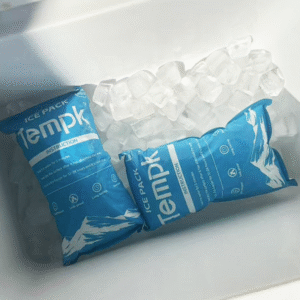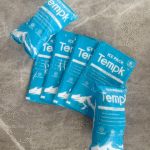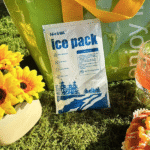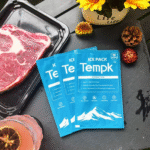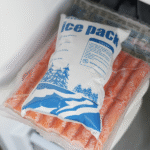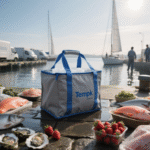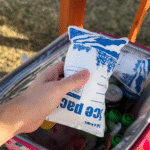Feuilles de glace carbonique vs briques de glace carbonique: Lequel devriez-vous choisir pour l’expédition?
L’expédition de produits sensibles à la température nécessite un examen attentif des méthodes de refroidissement, surtout quand on utilise de la neige carbonique. Comprendre les principales différences entre feuilles de glace carbonique et briques de glace carbonique est crucial pour les entreprises qui comptent sur ces produits pour maintenir l’intégrité de leurs marchandises pendant le transport. Cet article approfondit les caractéristiques, avantages, et les défis de chaque solution de refroidissement, vous aidant à choisir le meilleur en fonction de vos besoins d'expédition spécifiques.
-
Comprendre les principales différences entre les feuilles de banquise et les briques de glace carbonique, y compris leur efficacité de refroidissement et leur maintien en température.
-
Apprenez les meilleures pratiques pour l'emballage et l'expédition avec de la neige carbonique, suivant 2025 règlements et directives.
-
Prendre des décisions éclairées sur quelle solution de glace carbonique convient à votre secteur, si vous expédiez de la nourriture, médicaments, ou échantillons de laboratoire.
Que sont les feuilles de glace sèche et les briques de glace sèche?
La glace carbonique se présente sous deux formes principales: feuilles de glace carbonique et briques de glace carbonique. Les deux sont conçus pour maintenir des températures basses, mais ils offrent des avantages différents selon la nature de l'envoi.
Feuilles de pack de glace sèche
Les feuilles de glace carbonique sont flexibles, de fines feuilles de neige carbonique qui sont souvent à base de gel. Ces feuilles sont idéales pour les petits, expéditions peu encombrantes qui nécessitent un refroidissement contrôlé mais pas des températures de congélation. Ceux-ci sont couramment utilisés pour la nourriture, médicaments, et dispositifs médicaux qui doit rester entre 2°C et 8°C.
Briques de glace carbonique
D'autre part, briques de glace carbonique sont des blocs solides de dioxyde de carbone. Ils se subliment plus lentement et conservent une consistance, température ultra-basse de -78.5°C. Ce sont parfait pour les expéditions de longue durée ou des articles qui nécessitent congelant, tel que aliments surgelés, vaccins, et les biologiques.
Avantages de la glace sèche:
1. Refroidissement efficace
La glace carbonique absorbe la chaleur et maintient une stabilité, environnement froid. Que ce soit sous forme de feuille ou de bloc, il est conçu pour préserver les produits sensibles à la température pendant le transit.
2. Pas de résidu liquide
Contrairement à la glace traditionnelle, La glace sèche ne fonde pas dans l'eau. Cela signifie qu'il y a pas de gâchis, ce qui en fait une option privilégiée pour expédier des articles comme viande, fruit de mer, et produits pharmaceutiques.
3. Rentable
Même si la glace carbonique peut sembler plus chère à première vue, sa capacité à maintenir la température sur de longues périodes aide les entreprises éviter une détérioration coûteuse des produits.
Pourquoi choisir des briques de glace carbonique ou des feuilles d'emballage?
Pour les expéditions longues: Briques de glace carbonique
Briques de glace carbonique offre durées de refroidissement plus longues en raison de leur taux de sublimation plus lent. Ils sont idéaux pour expéditions longues, surtout quand produits surgelés doivent être conservés à des températures constamment basses jusqu'à 5 jours.
-
Plage de température: −78,5 ° C
-
Durée de refroidissement: 72–120 heures
-
Applications: Vaccins, biologique, aliments surgelés
Pour plus court, Envois sensibles à l’espace: Feuilles de pack de glace sèche
Glace sèche emballer des feuilles sont souvent plus flexibles et rentable. Ils sont parfaits pour petites expéditions ou ceux nécessitant glacé températures sans atteindre le point de congélation.
-
Plage de température: 2°C à 8°C
-
Durée de refroidissement: 24–48 heures
-
Applications: Médicaments, nourriture fraîche, produits de beauté
Une comparaison côte à côte
| Solution de refroidissement | Plage de température | Durée de refroidissement | Cas d'utilisation |
|---|---|---|---|
| Feuilles de pack de glace sèche (Gel) | 2°C à 8°C | 24–48 heures | Médicaments, nourriture réfrigérée, kits de repas |
| Briques de glace carbonique (Co₂ solide) | −78,5 ° C | 72–120 heures | Aliments surgelés, biologique, vaccins |
Quel est le meilleur pour votre envoi?
Choisir entre feuilles de glace carbonique et briques de glace carbonique dépend de plusieurs facteurs:
-
Durée de l'expédition: Pour les expéditions plus longues, les briques de glace carbonique sont la meilleure option. Ils assurent un refroidissement prolongé, ce qui les rend parfaits pour les expéditions de plusieurs jours.
-
Taille de l'envoi: Les feuilles de glace carbonique sont idéales pour expéditions compactes où l'espace est une préoccupation.
-
Budget: Les feuilles de glace carbonique sont plus rentable par rapport aux briques, ce qui en fait un bon choix pour plus petit, expéditions moins urgentes.
Meilleures pratiques pour une expédition de glace carbonique sûre et efficace
Un emballage et une manipulation appropriés sont essentiels lors de l'expédition avec de la neige carbonique. Voici quelques bonnes pratiques essentielles pour garantir un fonctionnement optimal de votre glace carbonique:
1. Directives d'emballage
-
Utiliser des conteneurs isolés: Emballez toujours de la glace carbonique des cartons bien isolés pour réduire le transfert de chaleur et prolonger le refroidissement.
-
Assurer la ventilation: La glace sèche sublimait le dioxyde de carbone, ce qui peut provoquer accumulation de pression si coincé dans un contenant hermétique. Laissez toujours les évents ouverts ou utilisez un emballage ventilé pour permettre au gaz de s'échapper en toute sécurité..
2. Étiquetage et documentation
-
Étiquettes de danger appropriées: La glace sèche est classée comme un matières dangereuses par l'ONU. Utilisez le bon étiquetage, y compris le « Dioxyde de Carbone, Étiquette « solide » et Numéro UN1845.
-
Documents d'expédition: Assurez-vous que les documents d'expédition reflètent avec précision la quantité de neige carbonique et incluent les instructions de manipulation appropriées..
3. Directives de poids et de quantité
-
Limites d'expédition: La quantité maximale de neige carbonique par expédition est généralement 5.5 livres (2.5 kg), avec des documents supplémentaires requis pour les expéditions plus importantes.
-
Calculer les besoins en glace carbonique: Pour les expéditions de courte durée, prévoyez d'utiliser 0.5× le poids du produit dans la neige carbonique. Pour les expéditions plus longues, augmenter le montant en fonction de la durée de refroidissement.
2025 Tendances de l'expédition de la glace sèche
Alors que nous regardons vers 2025, l'industrie du transport de glace carbonique évolue pour répondre à la demande croissante de durabilité et intégration technologique:
Emballage durable
De nombreuses entreprises sont investir dans des blocs de glace carbonique réutilisables et emballage respectueux de l'environnement des solutions pour réduire leur empreinte carbone. Cette tendance s’aligne avec l’attention croissante portée à la responsabilité environnementale.
Capteurs intelligents pour une surveillance en temps réel
Avancées dans emballage intelligent permettre le temps réel surveillance de la température, garantir que les marchandises sensibles à la température restent dans la plage souhaitée pendant le transport.
Systèmes de recyclage en boucle fermée
Certaines entreprises ont adopté systèmes de recyclage de glace carbonique en boucle fermée, permettant à la glace carbonique d'être réutilisée plusieurs fois, réduire les déchets et réduire les coûts.
Questions fréquemment posées
Q1: Comment calculer la quantité de neige carbonique pour mon envoi?
Pour 24-expéditions en heures, utiliser 0.5× le poids du produit dans la neige carbonique. Pour 48-expéditions en heures, faire correspondre le poids de la neige carbonique au poids du produit.
Q2: La glace sèche peut-elle être utilisée pour les expéditions internationales?
Oui, mais veillez à respecter réglementations internationales et garantir une documentation appropriée pour chaque pays.
Q3: Combien de temps la neige carbonique peut-elle maintenir une température froide?
Les briques de glace carbonique peuvent maintenir des températures ultra-basses jusqu'à 120 heures, pendant que les feuilles de glace carbonique peuvent durer 24-48 heures selon les conditions.
Conclusion: Choisir la bonne solution de glace carbonique
Sélection de la solution de glace carbonique appropriée :feuilles de glace carbonique ou briques de glace carbonique—dépend des exigences de température de votre produit, durée d'expédition, et le budget. En suivant les meilleures pratiques décrites dans cet article et en restant informé des dernières tendances en matière d'expédition de glace carbonique, vous pouvez assurer le transport sûr et efficace de vos produits sensibles à la température.
Prochaines étapes pour votre entreprise:
-
Passez en revue vos protocoles d’expédition pour déterminer quelle solution de glace carbonique correspond à vos besoins.
-
Assurer le respect des 2025 règlements concernant l'emballage, étiquetage, et documentation.
-
Collaborez avec des experts en logistique pour optimiser votre chaîne du froid et réduire les risques de détérioration.
À propos du tempk
Tempk se spécialise dans la fourniture solutions de pointe pour la chaîne du froid adapté à vos besoins d'expédition. Des produits de glace carbonique aux systèmes logistiques avancés, nous veillons à ce que vos marchandises sensibles à la température atteignent leur destination en toute sécurité et efficacement. Contactez-nous aujourd'hui pour une consultation sur l’optimisation de vos solutions de chaîne du froid.






